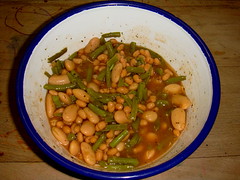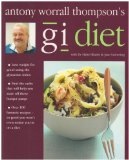So here we are: Monday Munchie time and I thought I would write a little bit about living with a diabetic (type ii) husband and his low GI diet… actually we all pretty much follow it – since it is healthy, makes sense and it isn’t a fad. Also diabetes is a genetic disease my children need to know how to eat properly and healthfully and have a taste for it, long before they get a taste for all the high fat, high sugar and high salt things that are so available.
When my husband was first diagnosed with diabetes I was totally clueless about what he should or shouldn’t eat… and the whole world has plenty of advise for the most boring dry food in the world but do you really want to live like that – I don’t think so! Turns out Diabetics can lead a pretty normal diet – they don’t live on dehydrated sawdust, but they do have to do everything in moderation – that is the dietitians’ moderation – not ours!
So here are Se7en Low Gi Points to ponder:
- Firstly what is a low GI diet – GI stands for Glycemic Index and is a measure, on a scale of 1-100, of how much a food containing carbohydrate will affect blood glucose levels.
- Low GI foods under 55 GI: release their glucose slowly and leave your tummy feeling fuller longer.
- Medium GI foods between 56 – 69 GI: release their glucose a little faster and so make us feel hungrier a bit quicker.
- High GI foods above 70 GI: Obviously release the glucose into your bloodstream the fastest and leave you hungry pretty quickly.
- Here is a list of low, medium and high GI foods. You can find lots of these lists, none of them are comprehensive, but they do give you idea of what you should be replacing and what you can do to eat more healthily. And if you cannot find a food, well you can search for a particular food on this table and they will give you the GI for that food around the world – really interesting.
- When we started eating Low GI foods everything seemed so complicated, list of foods and their GI’s and so on. Actually it as been really easy to incorporate it into our lives, just swopping high GI foods for low ones.
- So base your breakfast on low GI oats;
- Pop a bit of oat bran into anything you can
- Always eat rye or whole-grain breads
- Eat more sweet potatoes and fewer potatoes
- Use Basmati rice when you cook with rice
- Eat pasta instead of potatoes
- Use beans wherever you can.
- Gabi Steenkamp is a leading author and dietician in South Africa, she has a fabulous website full of tips and ideas. Really go and have a look at it if you want to know more.
- Liesbert Delport and Gabi Steenkamp are prolific authors and a have a whole series of Low GI recipe books: Their first popular recipe book, that I have used over and over again, was:
They have a fabulous recipe for bran muffins, you have to prepare them the night before and you can leave the mixture covered in the fridge up to a month… not likely in our house! It is lovely to wake up in the morning and pop the mixture into the pan and then you have fresh muffins for breakfast just 15 minutes after you pop them in the oven. Secretly, I think that you have to make the mixture the night before because the recipe requires so many ingredients you would have to get up just a little early in the morning to get breakfast!!!
They have a brilliant three bean salad, it is really quick and easy and I keep the beans in cans in the cupboard – at the ready. In most families this salad can last up to two weeks in the fridge. It is brilliant for going away for the weekend and when we go out for meals, specially braais (a South African version of the barbeque), where there is often noting for a diabetic to eat, this is a great tummy filler.
- Since their first book they have expanded into a series of cookbooks with a sample recipe from each of them on their website. Each of their books starts with an introduction with the latest information on low GI foods.We especially like the kids cookbook: Sustained Energy for Kids, which is packed with ideas that I use in the father persons lunch box. The recipes look fabulous and fun – not dreary and so healthy that no-one can face them. Here is a sample of se7en:
- muesli pie
- colorful coleslaw
- potato wedges – our celebrity chef loves making these
- apple and spice cupcakes
- apricot fingers
- chocolate cake – this one is really great!
- pineapple fluff
- chicken finger-strips
- mexican mielie bread
- cranberry muffins
- poppy seed rusks
- choc-dipped coffee triangles
- melktert nests
- fruity custard slices
- You do get lots of other Low G.I. cookbooks on the market and the one we like best is :
Now Antony Worrall Thompson, has produced one of the most unhealthy desserts on earth with his with his Snicker Pie. You can find the recipe on the BBC recipe site with a health warning attached to it. But clearly there have been a few life altering moments and lifestyle changes since then because he has written a number of Low Gi and diabetic cookbooks.
With that introduction you know his foods are not going to be skimpy recipes for twigs – but real hearty food like:
- blueberry muffins
- Caribbean smoothie
- lamb and barley soup
- smoked haddock
- salmon and prawn pie (hmmm!)
- pear crumble
- rice pudding
Totally yummy all of it!
They recently brought out:
With recipes like:
There you go, just because you are diabetic doesn’t mean you have to eat only dreary food – in fact fabulous food is it!
For more tips about absolutely everything pop over to Works for Me Wednesday.






15 Replies to “Se7en Tips About Low G.I. Diets…”